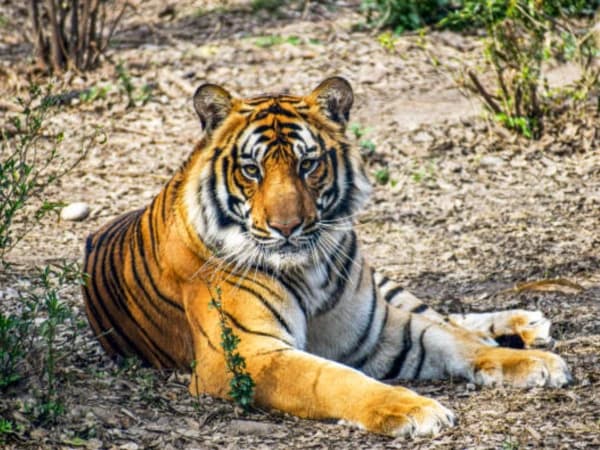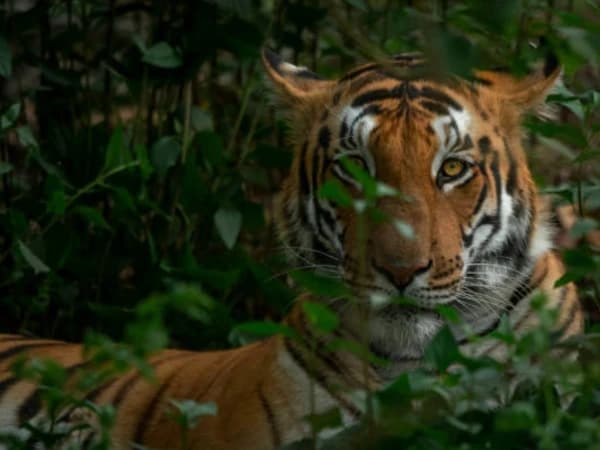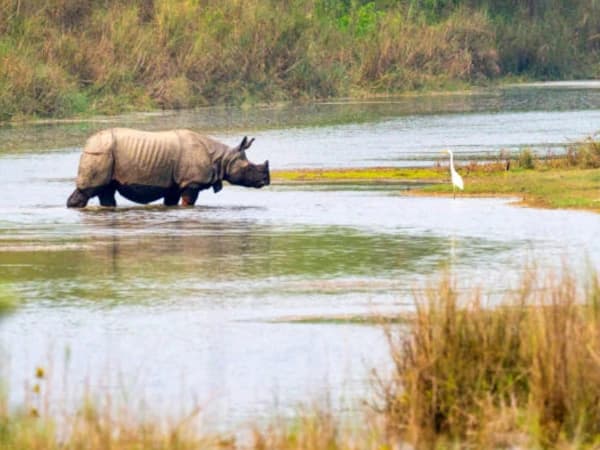Venture into the scenic wilds of Nepal’s Terai region to discover a stunning nature reserve where you’ll find countless wildlife species and quickly fall under nature’s spell. This is the Bardiya National Park: a forested sanctuary where wild tigers, elephants, and rhinos move freely against a backdrop of incredible beauty. In fact, the rich soil and subtropical climate in this part of Nepal have given rise to a staggering variety of flora and fauna. The Bardiya National Park is a place where sal trees cast long shadows across riverine forests and sprawling grasslands; where gharial crocodiles lie in wait on the banks of slow-moving rivers; and where tourists come from all over the world to discover the indelible beauty of one of Nepal’s best national parks. When you partner with Iconic Himalaya Adventure to explore this far-reaching wilderness, we’ll make sure that you see everything the park has to offer.
Bardiya National Park protects approximately 968 square kilometers of wild jungles and wooded lowlands: an area that’s been under some form of legal conservation since 1976. Although the reserve has had a few different names over the years and didn’t become a national park until 1988, it’s always stood as a shining example of conservation in Nepal. Thanks to strict security and translocation efforts from the Chitwan National Park, Bardiya is now home to a flourishing population of rare one-horned rhinos. While some tour operators allow guests to ride tame elephants into the jungle to find them, Iconic Himalaya Adventure strongly recommends avoiding these activities. The methods used to tame wild elephants are cruel and controversial, and we’ve prepared a number of ethical alternatives to ensure that your jungle safari in Bardiya National Park is unforgettable—and you might just see some truly wild and free elephants along the way.
There are plenty of smaller delights to discover in Bardiya National Park, too—the reserve is a bona fide paradise for birdwatchers, who will find a tremendous variety of cranes, warblers, babblers, and floricans here. Even if you aren’t a dedicated birder, it’s hard to look away from the iridescent beauty of a peacock’s plumage when its feathers are unfurled in a dazzling display for its peahen counterparts. And in the waters of the Karnali River, the extraordinary Gangetic dolphin can be found: this is an exceedingly rare porpoise that specializes in eating fish. In the company of trained and talented guides, you’ll learn to observe all of these animals without disturbing the delicate balance of nature, and this is what really makes a jungle safari in Bardiya National Park an unforgettable part of your travels in Nepal.
Highlights
-
Come face-to-face with the rare and beautiful Bengal tiger.
-
Venture into the Babai Valley to discover free-roaming herds of wild elephants.
-
Discover the smaller delights of the wilderness on a half-day jungle walk.
-
Enjoy authentic cultural encounters with locals from the Tharu community.
Major Attractions of a Jungle Safari in Bardiya National Park
When you travel to Bardiya National Park to enjoy an authentic safari in Nepal, the park’s wildlife is sure to be the star of the show. And while this reserve doesn’t attract the same number of visitors as the more popular Chitwan National Park, this absence of crowds is actually one of the primary draws of the Bardiya National Park. When you encounter a one-horned rhinoceros, a herd of wild elephants, or even a tiger in this wilderness, you’ll probably have the sighting almost to yourself. It’s a real treat to spend as much time as you’d like in the company of these wild animals without the pressure of sharing your sighting with a bevy of other vehicles and tourists.
There are also many smaller, quieter wonders to discover within the bounds of Bardiya National Park. Birdwatchers will fall in love with this scenic wilderness, which serves as an important habitat to approximately 500 unique species. And when you embark upon a half-day jungle walk in the park, your guide will introduce you to some of the park’s smallest creatures: turtles, skinks, geckos, and more. If your adventures bring you to the waterways of Bardiya, you may even be lucky enough to encounter the incredibly rare Gangetic river dolphin. And because your safari activities in Bardiya National Park will be led by guides with an incredible breadth of knowledge, you’ll learn all about the natural and cultural history of this fascinating part of Nepal along the way.
Who Can Enjoy a Jungle Safari in Bardiya National Park?
Discovering Nepal’s wild places is easier than ever before, and almost anyone can experience the wonder of a safari in Bardiya National Park. Most safari activities involve riding in an open-top vehicle, taking photographs of the animals and places you see along the way. This is a safe and sedentary activity, though some of the roads in the park are bumpy. Jungle walks in the park are also slow-paced and easygoing, as we’re focused on discovering the smaller delights of the bush, and you won’t be expected to cover much distance. For these reasons, travelers of all ages can enjoy a safari in Bardiya National Park. Of course, we do require that all children be accompanied by an adult guardian, and please let us know if anyone in your party has a health condition that may affect their ability to participate in a Bardiya safari.
How Safe is a Safari in Bardiya National Park?
The professional rangers and guides at Bardiya National Park have spent years working in this one-of-a-kind wilderness, and when you join Iconic Himalaya Adventure on a safari here, you’re in good hands. While it’s true that any safari in the wilderness carries some element of risk, the guides here are specially trained to observe animal behavior. They’ll know exactly how close you can approach animals in the wild, especially when you’re enjoying an on-foot jungle walk, and they can read all of the hidden signs of the bush to know where wildlife might be found. For these reasons, a safari in Bardiya National Park is generally quite safe—just be sure to wear sturdy shoes, apply insect repellent, and listen to your guides. We’re committed to ensuring that you have a secure and unforgettable safari in Bardiya National Park.
When is the Best Time to Visit Bardiya National Park?
There’s no bad time to discover the wonders of Bardiya National Park, and you can embark upon a safari here at any time of year. But there are a few factors to consider when it comes to wildlife visibility and weather.
- If you want to see tigers above all else, consider visiting Bardiya National Park between March and June. As springtime rolls into summer, the bush comes alive with greenery. While temperatures may soar to uncomfortable heights at this time of year, this kind of weather often brings tigers out into the open as they seek relief from the heat in the rivers and lakes of the park.
- Nepal’s summer monsoon typically hits the wilds of Bardiya National Park in late June, often persisting until September. While heavy rains can make jungle walks more difficult, you’re sure to have the park virtually to yourself at this time of year. Just be sure to come prepared with plenty of rain gear!
- After the monsoon rains end by September, you’ll enjoy dry weather and pleasant temperatures. There are lots of colorful cultural festivals to discover at this time of year, with the celebrations of Dashain and Tihar drawing multitudes of Hindu faithful. Winters in Bardiya National Park are also fairly mild, so this ideal tourist season stretches into January or February of the following year.








